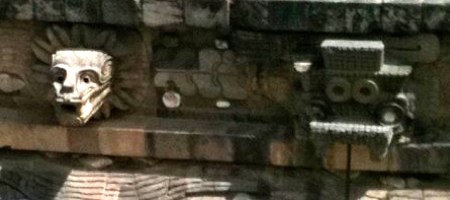Teotihuacan and Information
As you walk approach Teotihuacan, you run a gauntlet of booths that sell silly “Mexican” souvenirs. As you walk through the ruins, you are continually approached by people selling toys and trinkets. No one sells, or gives away, a guidebook or a map, not even the little (but often fairly good) “self-guided tours” that the U. S. Park Service hands out. The outdoor signage is trilingual but mediocre. The new museum signage is good but sparse, the old museum signage is even sparser and, since I was able to read it, is likely written in rather elementary Spanish. There are said to be tour guides, but where? And how good? There seems to be a bookstore, but it was small, oddly situated, and closed for inventory.

I don’t know much about Teotihuacan, beyond visits to the Field Museum and what one picks up here and there. I was limited to a very short visit. I had lots of questions.
- What’s restored? How do you tell? How solid is the restoration?
- Where are the potsherds? The metates? The hearths? We see lots of lovely figurines, jewels, and spectacular burial goods, but there’s surprisingly little bread and butter archaeology. And, simply walking around, I’m not seeing the scatter of potsherds that you see, for example, at Chaco.
- The peak population hit 100,000, so this was, for a time, the largest city on earth. How do we know the population? How solid is the estimate?
- What signage there is seems pretty confident about construction dates. How do we know? (Does dendrochonology work here? )
- Are there ballparks?
- A lot of this architecture seems to be designed for display paintings. Is that right?
- A number of buildings are said to be elite political-residential structures. How do we know that? How are they distinguished from religious structures?
- Teotihuacan is much larger than Pompeii or Ostia. The public spaces are vastly more impressive. But where are the bars and brothels and workshops? Where are the macaw pens and turkey corrals? How did people get water for cooking and drinking? Is that big open plaza really a market? Are there other markets? (Was there money?)
- The last phase of Teotihuacan is termed “Metapec”. Does this refer to the Tolucan town where, the previous night, we’d had such a nice dinner of beer and queso fundido with chorizo and some micheladas and some quesadillas and more beer and dominoes and some more beer? Why Metapec?
- There are stairs everywhere, and their risers seem to me to be uncomfortably high. Is there a “standard” riser? Is it in fact too tall, given the stature of the inhabitants? If so, why?
- What are the current controversies and recent developments?
True, you don't want to bury a site in signage. When you first encounter a site so clearly intended to evoke an emotional response, it would be a shame to have your nose in a book. But, still, there is so much to be explained (and so much to be gained from better understanding) that more needs to be done. An iPhone/iPad solution seems natural here – not so much for showing reconstructions (though this would reduce the temptation to deface the site with reconstructions to impress casual visitors) but rather to provide lots of additional information to the curious.